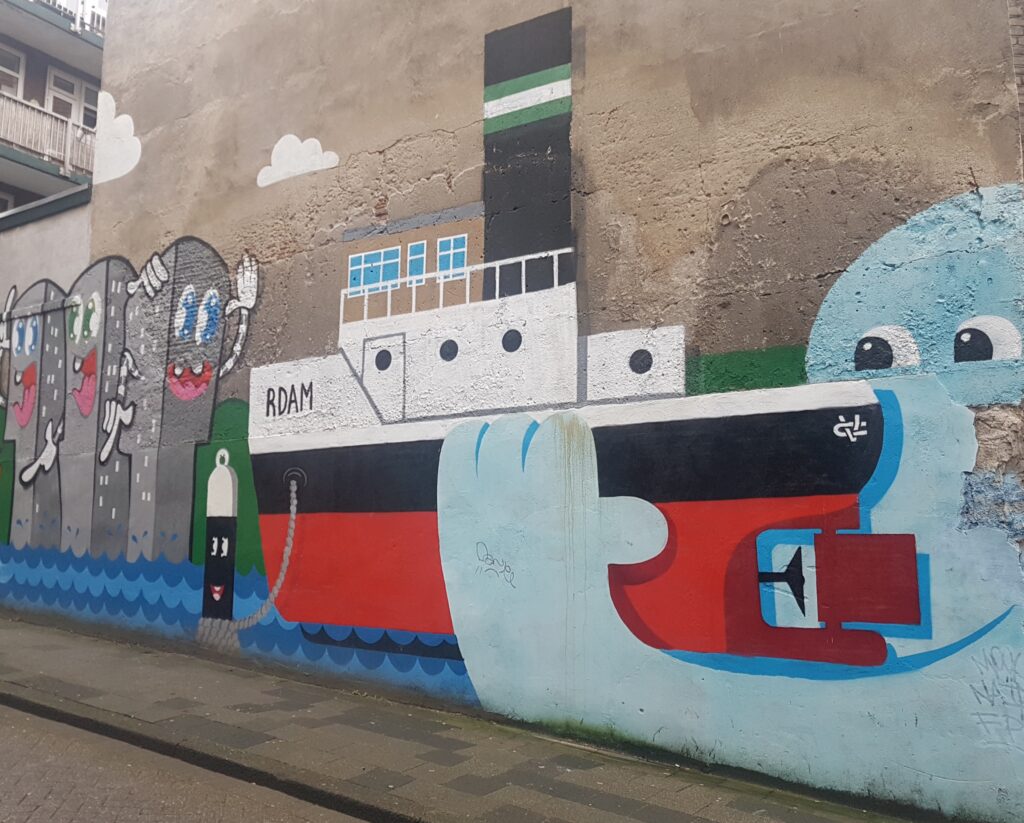
This article explores a Rotterdam area partnerships approach to organized crime/urban decay, and includes overviews of new understandings around this topic that will be of interest to landlords and communities struggling with high crime areas and long-term problems.
The situation
Rotterdam-Zuid is an unusual neighbourhood for the Netherlands, but one all too familiar in England. It is riddled with disproportionate levels of crime, poverty, unemployment. It seems that the ‘best life’ that comes easily to Dutch living elsewhere in the Netherlands does not come so easily to the residents of Rotterdam-Zuid and the explanation given for this is one you may never have heard of; undermining crime.
What is undermining crime?
We have no directly translatable equivalent of ‘undermining crime’ in English. It is defined as a subset of organised crime that damages both the formal structures, such as trust in the police and the informal structures, such as having friends and family not involved in crime, which safeguard the functioning of society. It takes place in networks and takes forms such as drug-dealing, money laundering, human trafficking and cyber crime; creating parallel economies and cultures. Unlike the British concept of ‘organised crime’ which conjures an image of a group of people committing crimes for rational motives such as profit that are either framed as impressive (jewelry heists) or heinous (heroin dealing);undermining crime is faceless. It is committed for unclear, irrational reasons in addition to more obvious rational ones. It is unclear where the blame lies. It is messy, multi-faceted, it impacts on everyone and it is ultimately everyone’s responsibility. It is a ‘contextual’ way of conceptualizing crime that requires new ways of thinking, organising and doing.
The usual approach of more enforcement and other control and information-based measures were used in Rotterdam-Zuid but with little to no success. Wicked problems by their nature adapt and respond to interventions, and more of the same is going to have a limited effect. New understandings of problems require new approaches for the organisations tasked with dealing with them.
Undermining crime is understood by the Dutch to be a ‘wicked problem’. Wicked problems are considered difficult or impossible to solve due to their interconnected causes, changing nature and the difficulty in obtaining a complete understanding of them. They also have no discernible stopping point. This understanding is of itself a challenge to an English mindset orientated towards individual responsibility as explanation for and solution to complex social problems.
Wicked problems are complex
An approach that is often used to understand the organisations tasked with managing wicked problems is the complexity framework.
The complexity framework helps to understand the management of approaches to problems that cut across boundaries, have many individuals and organisations involved, contain a high degree of uncertainty and the contexts that host the problems are volatile and unpredictable. It is an approach that acknowledges the irrational, human component both of those considered part of the problem and those tasked with dealing with it.
The framework locates individuals and organisations tasked with tackling the problem as part of the problem and subject to the same scrutiny, requiring new thinking about accountability, impact and how both organisation strategy and back office work, relate to front line functions.
Moving from new understanding to practical action
While wicked problems/complexity framework provide new ways to ‘see’, Nudge Theory is utilized as a tool. It is not used as the primary way to understand and explain the problem of undermining crime. As a recap Nudge was made famous by Thaler and Sunstein’s 2008 book of the same name. The idea is by making simple changes to contexts (called choice architectures in the book) advantage can be taken of people’s inbuilt thinking errors called ‘heuristics’, which in turn produce ‘biases’ in thinking. By focusing on changes to the environment, rather than directly manipulating these heuristics and biases, individuals are still free to choose but are gently nudged towards making choices that are better for themselves and those around them, incrementally leading to better environments and behaviours over time.
Other more traditional approaches such as enforcement and community engagement continued to be used alongside Nudge.
Dutch networks
In response to managing the issue of inter-organization complexity the Hartcore multi-agency partnership was set up in Rotterdam-Zuid. Unlike the English approach of task and command meetings, the partnership operates as a network.
On the surface the partnership may appear similar to the those in England, but it is qualitatively different. A key influence is a cultural one; overleggen is a form of practical negotiation that acknowledges each party starts from a different starting point and all aim to reach a practical outcome. We have no equivalent concept in English. It is an inherently rational and centralising approach to organisation. It is a concept I am still exploring, but from what I can see so far, it tends to encourage more trust across the network, more reasoned freedom to experiment(ideas need to be backed up, you need to explain them to your partners after all), a mix of formal and informal approaches to communication, a chat coffee is as important as a formal meeting, and more ownership of a shared sense of direction and purpose – not goals and targets. There are still issues, who gets excluded from the network for example. It is also an approach that requires a lot of rational skill and ability, so more emotional experiences, which are essential understandings when dealing with homes and communities, may unintentionally get excluded.
The partnership also took a different approach to the issues of measurement and accountability.
Measurements and accountability
The Hartcore partnership utilised a new Dutch approach called ‘Rijker Verantwoorden’, which loosely translates to ‘enriched accountability’. The central notion is numbers alone distort reality and expected and experienced effects are as important. This means expectations rather than targets are set so a sense of direction is established rather than fixed numeric goals. Experienced effects focus in on measuring what it feels like to live work and be in Rotterdam-Zuid.
Rijker Verantwoorden shifts focus away from a causal sense of thinking – trying to ‘prove’ that intervention A caused outcome B. This type of thinking tends to breakdown when the context, rather than individuals are the target of intervention.
There is also a complete absence of constructing a £-value for the intervention in Rijker Verantwoorden, as this would be considered adding an extra layer of distortion and distraction away from measuring what is actually occurring with intervening in the problem. This is again a significant challenge to the English mindset where accountability seems inextricably tied up with accounting and linear logic permeates organisation cultures and reporting systems.
So, what happened?
My time in the Netherlands highlights how English thinking about problems tends to strip out the context which in my view is a fundamental flaw. Failure to acknowledge contextual issues at the very least results in ineffective use of approaches such as Nudge and at worst harm that ripples out into the wider organisation networks,the problem and the individual supposedly helped by interventions.
The Hartcore partnership utilised 12 interventions using Nudge based approaches and a few are highlighted here. A brief description is given of the Nudges used in the examples.
| Type of Nudge used | Description |
| Framing | Peoples choices are influenced by the way the choices are presented. For example,‘90% of people survived the operation’ sounds different to ‘10% of people died’, even though the information is the same. |
| Social Norms | People are a lot more likely to go along with the behavior that seems normal in their environment as people have a strong desire to belong to immediate social groups. |
| Simplification | We are all subject to cognitive overload. Thinking consumes energy! People in stressful circumstances or leading busy lives have limited mental bandwidth left to puzzle out new information, so are more likely to choose options that are presented in a way that is easier to understand or action. |
| Environmental interventions | These where a mix of interventions that aimed to shift the ‘experience’ of the area in a positive direction. |
Changing street layout to make it feel safer
Environmental interventions were the primary Nudge used here. This is not ‘designing out crime’ or ‘target hardening’; seen through a Nudge lens some of these interventions would make a place feel more unsafe as visible crime deterrents can make it feel as if crime is normal in that location. Instead changing the experience of a place to make it somewhere that people want to go,and acceptable standards of behavior are encouraged is the Nudge inspired approach. Ideas included removing awnings to open up the space and make it lighter to having an organ grinder play where young people where loitering and behaving poorly. There is no fixed recipe as each context is different, but there’s room to be creative and engage the people you want to see there.
Early Birds –Changing attitudes to interventions in children’s anti-social behavior
‘Framing’ was the primary nudge utilized here. Rather than focusing on ‘your child has done something wrong’ the script was changed to ‘we are worried about your child, can we help?’ – with the obvious need to have the help to refer into. Nudge is essentially a trigger here, if there is not a supportive context to refer into, then the outcome is likely the same regardless of how the intervention is framed.
This shows the value of the complexity framework; it forces an examination of the referral context. Does it exist?Is it designed based on rational principles alone without regard to how human beings think, live and feel?Who does the intervention actually benefit, the recipient or the organisation? What cultural assumptions are built into the intervention? These and other questions need to be asked of referral-based interventions; changing the trigger point alone is unlikely to change the long-term outcome.
Vlogs of real day-to-day work
These were created by the Police utilizing the Nudges of ‘Framing’, ‘Social Norms’ and ‘Simplification’. The Vlogs aimed to tell the complicated story of police work so the public and partner agencies could understand it – in this case why it took so long to take action against a problematic Coffeeshop (a cannabis shop).
A lot of social housing work is bureaucratic and complicated, from allocations policies, to anti-social behavior cases. This leaves room for myths and problems to grow that can have hugely damaging ripple out effects, possibly contributing to the large amounts of stigma surrounding the English social housing sector. Small changes in how information is presented can have large effects. The Vlogs benefited not only the Police’s relationship with the public but also strengthened connections with network partners, so enhancing the network’s ability to undertake its difficult task of tackling undermining crime.
Cultural considerations
Some observed cultural differences between English and Dutch approaches are compared below. They are by no means exhaustive or rigorous and are intended as food for thought, not factual statements.
| Netherlands | England |
| Undermining crime – a subset of organised crime that emphasises its faceless, irrational and contextualised nature and the role it plays harming formal and informal social institutions. | No equivalent in English culture. The closest we have is organized crime which suggests a group conspiring to commit crime solely for profit and has no contextual or understanding of irrationality within it. |
| Networked partnerships – prioritises negotiation and compromise throughout the network and the identification of shared goals. | Tasking partnerships– emphasis on project management, top down task allocation, reducing problems to numbers and budget management, individual/organisation accountability rather than development of shared goals. |
| High levels of trust – trust flows throughout the partnership network. Is maintained and supported with overleggen. Lower levels of trust for people located outside of the network – same is true for any insider/outsider group structure. | Low levels of trust – more audit and oversight culture. Low levels of sociable networking, fear of failure, little to no self-reporting permitted, focus on numeric based reporting systems and producing data to fit these. |
| Rijker Verantwoorden – numbers are distortions of reality, not reality. High value placed on direction setting and experience-based measures. | Numerical/financial/distanced accountability – questions of worth often framed as £-value. Little to no serious attention given to non-numeric/financial outcomes. Reporting mechanisms often distant and separated from the actual experience of the service, based on numeric indicators, audits and targets instead. |
| Target the context/environment – partnership interventions primarily focused on context; individuals located within it are secondary targets. | Target the individual –interventions focused on targeting individuals either directly or by commissioning contracts to deliver services to individuals to enable their behaviour change, not change the circumstances around the individual. |
| Understanding – problems are approached as things to be understood rather than solved. Frameworks are sought to help understand the problem and approaches are developed using these. Closer connections between those delivering the services and those receiving it. | Instrumentalisation – problems over simplified and stripped from context. Rarely approached from a framework to aid better understanding, assumed knowledge often solely used. Where theory is used, it is used in a toolkit fashion, often resulting in trends and fashions in approaches that do little to actually change the underlying problem. |
| Rotterdam-Zuid problems are considered unusual but on the increase. Problems to be approached by understanding, engaging and supporting. Frustration often experienced by authorities when communities don’t engage. | Such problems are considered fairly endemic in urban areas and a problem of poor individual behavior. Problems solved by being tougher on crime. |
| Housing Corporations play little role in crime and community initiatives. Much larger role for local authority equivalents and city governance. This is gradually changing as housing corporations are taking on more vulnerable tenant populations. | Housing Corporations and other housing providers play a significant role in crime and community initiatives. Arguably having a more significant stake in the environment of housing stock than other stakeholders. Our sector’s strong interest in environmental livability suggest that contextual interventions should be of strong interest. |
Conclusions
There is food for thought in the Dutch approach to ‘undermining crime’, from the locating of the topic as a ‘wicked problem’ and how that shapes how it’s thought about. The actual definition of it also sparks off new ways of thinking which can help develop new approaches about long running problems in England. Fundamentally how we perceive the problem changes our approach to dealing with it.
It’s also essential to get a sense of Dutch organizational culture and the wider cultural values that underpin this. There is a lot more to cultural influence than covered in this article, the exploration of how overleggen changes the nature of partnerships into networks shows how one small difference can have a huge effect.
Contextual interventions,wicked problems and the messy networks that are needed to orchestrate them call for a different framework of understanding and the complexity framework meets this need.It highlights the weaknesses in rigid organizational structures and ensures that involved organisations and individuals are also located as part of the problem. This is hugely challenging to organisations who have grown comfortable with the messy world sitting outside of their perfect systems; an uncomfortable lie that complexity framework burns through with its stark honesty that the line separating organisations from the problems they intervene in is a construct; by taking action, you become one of the parts of the problem; and with all parts of the problem working together, problems can be addressed.
An area that seems particularly complicated for both countries is measurement and accountability. England’s over focus on £-value and numbers fails to capture the nature of the problem but produces great data for reports while the Rijker Verantwoorden approach relies heavily on self-reporting and existing measures, building in a bias towards seeing interventions as successful.So how do you measure interventions into wicked problems? Especially those that occur in open systems of neighbourhoods and communities? This measurement problem is a key strand of my thesis research and one that I will revisit in later articles.
I hope that this article has demonstrated the value of looking overseas for inspiration and also that ideas come with the need to have a rich understanding of the context that the come from.I encourage you to think new and fruitful thoughts about your own wicked and complex problems.
The body of this work is based on the Master’s thesis research of Myrthe van Delden. Reflections on culture and transferability to England are my own.



